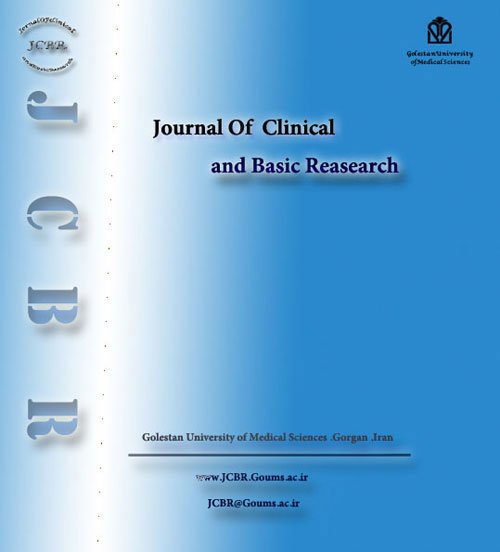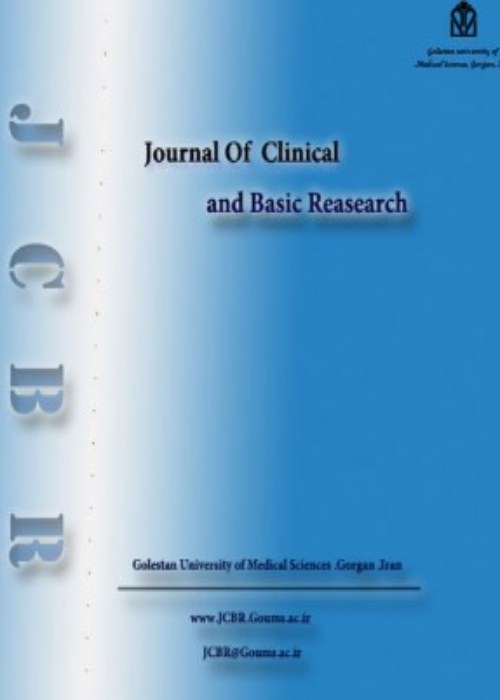فهرست مطالب

Journal of Clinical and Basic Research
Volume:4 Issue: 1, Winter 2020
- تاریخ انتشار: 1399/04/25
- تعداد عناوین: 4
-
صفحات 1-5هدف
علی رغم پیشرفت ها در مراقبت های دوره بارداری، نوزادان مادران دیابتی درجات بالایی از ناخوشی و مرگ را تجربه می کنند. هایپرتروفی سپتوم بین بطنی یکی از اشکال شناخته شده ناهنجاری های عملکرد قلب در نوزادان مادران مبتلا به دیابت است. در این مطالعه هم گروهی تاثیر ابتلای مادر به بیماری دیابت بر بروز هایپرتروفی سپتوم بین بطنی مورد مطالعه قرار گرفت.
مواد و روش هادر این مطالعه هم گروهی 42 مادر باردار مبتلا به دیابت به عنوان گروه مواجهه داشته و 42 مادر باردار سالم به دیابت به عنوان گروه بدون مواجهه از طریق نمونه گیری در دسترس انتخاب شدند. ضخامت سپتوم در نوزادان این مادران به روش M-Mode اندازه گیری شد. مقایسه ضخامت دیواره سپتوم بین بطنی در نوزادان مادران دیابتی و مادران سالم و همچنین بر اساس وضعیت مصرف انسولین در نوزادان مادران دیابتی انجام شد. برای انجام مقایسه میانگین ضخامت سپتوم از آزمون من-ویتنی و همچنین آزمون کای-دو با استفاده از نرم افزار spss نسخه 16 و در سطح معنی داری 0.05 انجام شد.
یافته هامیانگین ضخامت دیواره سپتوم بین بطنی در نوزادان مادران دیابتی 5.84±1.44 و در نوزادان مادران سالم 4.51±1.58 بود (p<0.001). هایپرتروفی سپتوم (ضخامت سپتوم بیشتر از 6mm) در نوزادان مادران دیابتی 38% (17 نوزاد) و در نوزادان مادران سالم 14.2% (6 نوزاد) بود(029/0=p). بین ضخامت سپتوم بین بطنی نوزادان مادران دیابتی تحت رژیم غذایی (5.69±1.5) و مادران دیابتی مصرف کننده انسولین (6.14±1.32) تفاوت معنی داری مشاهده نشد (34/0=p).
نتیجه گیریمطالعه حاضر نشان داد که ابتلا به دیابت بارداری باعث افزایش ضخامت سپتوم بین بطنی در نوزادان می شود. همچنین کنترل سطح قند خون با مصرف انسولین تاثیری بر ضخیم شدن سپتوم بین بطنی ندارد.
کلیدواژگان: دیابت بارداری، سپتوم بطنی، نوزادان -
صفحات 6-13زمینه و هدف
ارزشیابی آموزشی، نقش ویژه ای در تعیین و ارتقاء کیفیت آموزشی دارد که بی تردید ضامن بهبود مستمر کیفیت آموزشی خواهد بود. اساتید ارکان اصلی دانشگاه ها هستند، که نحوه عملکرد آنها در بازده یک نظام آموزشی نقش اساسی ایفا می کند این مطالعه به منظور مقایسه نتایج خودارزیابی اساتید و ارزشیابی دانشجویان از عملکرد آموزشی اعضاء هیات علمی دانشگاه علوم پزشکی گرگان طراحی گردید.
روش بررسیاین پژوهش یک مطالعه مقطعی با رویکرد توصیفی-تحلیلی است که به منظور مقایسه نتایج خودارزیابی اساتید و ارزشیابی دانشجویان از عملکرد آموزشی اعضاء هیات علمی دانشگاه علوم پزشکی گرگان در سه سال تحصیلی 93-1390 با استفاده از دو پرسش نامه استاندارد ارزشیابی اساتید توسط دانشجویان وخودارزیابی اساتید انجام گرفت. داده ها پس ازجمع آوری با استفاده ازنرم افزارآماری SPSS-18 موردتجزیه وتحلیل قرارگرفت. برای توصیف داده ها ازروش های آماری توصیفی وبرای تحلیل، ازآزمون های شاپیروویلک، من ویتنی، ضریب توافق کاپا وICC استفاده گردید. سطح معناداری 05/0 درنظرگرفته شد.
یافته هااساتید شامل 66 نفر (6/34%) زن و 125نفر (4/65%) مرد و (8/78%) استادیار و (2/21%) دانشیار، با میانگین و انحراف معیار 88/6± 3/12 سال سابقه خدمت بودند. دانشجویان از 191 استاد، 24 نفر (56/12%) را با بیشترین نمره و 23نفر (04/12%) را با کمترین نمره ارزیابی کردند. میانگین نمرات اساتید خانم در هر دو ارزشیابی، بیشتر از میانگین نمرات اساتید آقا بوده است. بین نظر دانشجویان و خود اساتید در خصوص عملکردشان توافق نظر وجود داشت، اما این توافق بسیار کوچک بود.
نتایجیافته ها حاکی از آن است که با گذشت زمان از توافق بین نظر اساتید و دانشجویان کاسته شده که این مهم، ضرورت افزایش حساسیت مدیران آموزشی در استفاده از نتایج ارزشیابی و بازخورد آن به اساتید را بیش از پیش ایجاب مینماید.
کلیدواژگان: ارزشیابی، دانشجو، استاد، عملکرد آموزشی
-
Pages 1-5Background and objectives
Despite advances in prenatal care, there is a high rate of morbidity and mortality in infants of diabetic mothers. Interventricular septal hypertrophy is a well-known congenital heart abnormality in neonates of mothers with gestational diabetes. In this study, we investigate the effect of gestational diabetes mellitus on interventricular septum thickness.
MethodsIn this cross-sectional cohort study, 42 neonates from mothers with gestational diabetes mellitus and 42 neonates from non-diabetic mothers were selected from gynecology ward of Sayyad Shirazi Hospital in Gorgan (Iran) between April 2016 and April 2017. Ventricular septum thickness in neonates was measured by M-mode echocardiography. Comparison of septum thickness and frequency of septal hypertrophy between the two groups was performed using t-test, Mann-Whitney test and chi-square test. All statistical analyses were preformed in SPSS 16 at significance level of 0.05.
ResultsThe mean septum thickness was 4.51±1.58 mm in newborns of non-diabetic mothers and 5.84±1.44 mm in newborns of diabetic mothers (P<0.001). Septal hypertrophy (thickness of ≥6 mm) was significantly more common in newborns of diabetic mothers (P=0.029). In addition, we found no significant difference in septum thickness between newborns of diabetic mothers receiving diet or insulin therapy.
ConclusionOverall, our findings suggest that there is a significant correlation between gestational diabetes and ventricular septal hypertrophy. In addition, glycemic control with diet or insulin therapy has no significant impact on septum thickness.
Keywords: Gestational diabetes mellitus, ventricular septum, Neonates -
Pages 6-13Background and objectives
Educational appraisal plays a pivotal role in determining and promoting the educational quality and ensuring its continuous improvement. The performance of faculty members, characterized as the major building blocks of universities, makes significant contribution to the output of an educational system. Thus, the current study sets out to compare the results of the faculty members’ self-assessment and the students’ assessment of their educational performance in Golestan University of Medical Sciences, Iran.
MethodsThis cross-sectional, descriptive-analytical study was performed in academic years 2011-14 on faculty members and students at school of medicine in Golestan University of Medical Sciences, Iran. Data were collected using two questionnaires. Mean scores of educational performance were compared using the Mann-Whitney test. The Kappa and ICC agreement coefficient were used to assess the agreement between the professors and the students’ views. All statistical analyses were performed in SPSS 18 at significance of 0.05.
ResultsOverall, 191 completed questionnaires related to 49 professors were collected. In addition, 109 self-assessment questionnaires were collected from 48 faculty members. Of 191 professors, 34.6% were women, 65.4% were men, and 78.8% were assistant professors. In addition, the mean work experience was 12.3 ± 6.88 years. By comparing the highest and lowest self-assessment scores of the professors, of 191 professors, 31 (16.23%) assessed themselves with the highest score, which determined their strengths in explicit expression and full explanation of the content of the course, the perfect use of class time for educational activities, proper communication with colleagues, and responsibility for carrying out organizational tasks. Moreover, 25 (13.08%) of the professors assessed themselves with the lowest score mainly due to lack of research activities. A partially significant convergence was observed between the students and the faculty members’ assessment scores.
ConclusionThe convergence between the students’ ideas and that of the faculty members questions the practical value of evaluation programs and highlights the necessity to deliver the resulting outcome to the faculty members.
Keywords: Assessment, Student, Faculty member, Educational performance -
Pages 14-20Background and objectives
Diabetes mellitus is a metabolic disease characterized by hyperglycemia due to defects in insulin secretion or action. One of the consequences of diabetes is depression, which itself is related to complication of diabetes. Given the lack of enough studies on the relationship between psychological variables of parents and level of HbA1C in children with type 1 diabetes in Iran, we examined the relationship between psychosocial factors and glycemic control in children aged 7-16 years with type 1 diabetes.
MethodsThis is a cross-sectional study conducted on all children with type 1 diabetes who were referred to Taleghani children's hospital in Gorgan, Iran. Data were collected using the General Health Questionnaire, the Strengths and Difficulties Questionnaire and a parenting style questionnaire. The collected data were analyzed in SPSS software (version 17).
ResultsOverall, 64 diabetic children aged 7 -16 years who had a record file at the hospital were enrolled in the study. Children of homemakers and highly educated mothers had better glycemic control. In addition, the General Health Questionnaire test score of mothers had an inverse relationship with glycemic control in children with type 1 diabetes. Moreover, daring parenting style seemed to have a more positive impact on glycemic control of diabetic children compared to permissive and authoritarian parenting styles.
ConclusionOur findings demonstrate that various parental variables may affect glycemic control in children with type 1 diabetes. Children with poor glycemic control have more personality and psychosocial problems. We suggest endocrinologists to refer children with type 1 diabetes and their parents to psychiatrists for psychological assessment and psychoeducation.
Keywords: Psychosocial factors_Glycemic control_Type 1 diabetes mellitus -
Pages 21-31
The most important aspect of cancer treatment is early diagnosis. The best serum marker currently available for diagnosis of prostate cancer (CaP) is serum prostate-specific antigen (PSA). However, PSA test does not have high specificity and is not reliable for differentiating benign prostate hyperplasia, non-aggressive CaP and aggressive CaP. In the past decade, great efforts have been made in the development of novel biosensor-based strategies for detection of biomolecules and miniaturization assays for PSA. The emerging nanotechnology in recent years is expected to have a profound effect on healthcare and scientific research in the near future. Specifically, nanotechnology is foreseen to help solve one of the most challenging and longstanding problems of early cancer detection. The current mini-review summarizes the current knowledge and application of nanoarrays, nanosensors, liposomes, improved nanoparticles (dendrimers, diamondoids, gold-based nanoparticles, magnetic nanoparticles and quantum dots) and nanoelectronics in early diagnosis of prostate cancer. This mini-review highlights the most recent advances and innovative solutions in applications of nanotechnology for the detection of CaP biomarkers and early diagnosis of CaP.
Keywords: Prostate cancer, Nanotechnology, Diagnosis


